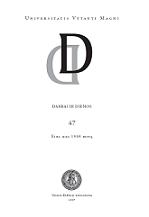Czeslawo Miloszo gimtinė: tautiniai ir konfesiniai pokyčiai po antrojo pasaulinio karo
Places native to Czeslaw Milosz: changes in the nation and religion during the second half of the twentieth-the beginning of the twenty first century
Author(s): Irena MiklaševičSubject(s): Language and Literature Studies
Published by: Vytauto Didžiojo Universitetas
Keywords: Places; native; Czeslaw; Milosz; nation; religion;; twenty first; century;
Summary/Abstract: Czeslaw Milosz was born in the vicinity of Kėdainiai, a multi-cultural region at the start of the 20th century, which was populated by Lithuanians, Jews, Poles and Russians along with the faith¬ful of a number of different religions. Kėdainiai, nonetheless, had been renowned as the primary centre of Protestantism in Lithuania since the 16th century. The aim of this article is to depict the changes in the nation and religion, taking place in Kėdainiai and its vicinity during the latter half of the 20th and beginning of the 21st century. This paper is based on contemporary theories of collective identity. In the social sciences, a transition from an orientation towards individual identity to collec¬tive identity has been observed. Ethnic and national identity has been key to such studies, evolv¬ing to investigations about behavioral changes in different ethnic groups. Conditional to such changes are cultural changes currently occurring in contemporary society. Ethnic identity results from individual choice, not only from the heritage of traditions, which can be viewed in a positive manner. Lithuanian identity itself may be undergoing changes, seemingly due to decreasing pride and practicality in national identity. Considerable changes in the national makeup of Kėdainiai took place during the Soviet oc¬cupation. The population of Russians increased by 55 percent and Lithuanians by 20 percent. Meanwhile, the number of Poles decreased by 71 percent and Jews by 44 percent. The explanation for this lies in the national policies enacted during that period.
Journal: Darbai ir dienos
- Issue Year: 2006
- Issue No: 46
- Page Range: 259-268
- Page Count: 10
- Language: Lithuanian

